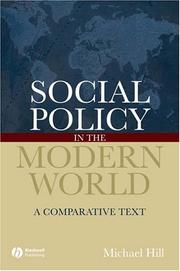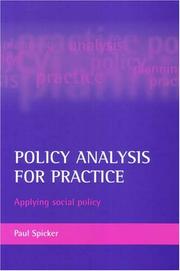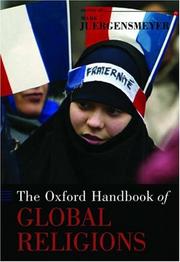| Listing 1 - 10 of 29 | << page >> |
Sort by
|

ISBN: 1405127244 9781405127240 1405127236 9781405127233 Year: 2006 Publisher: Malden Cambridge university press
Abstract | Keywords | Export | Availability | Bookmark
 Loading...
Loading...Choose an application
- Reference Manager
- EndNote
- RefWorks (Direct export to RefWorks)
#SBIB:316.8H00 --- Sociaal beleid: algemeen --- Public welfare --- Social planning --- Social policy --- Social security --- Insurance, Social --- Insurance, State and compulsory --- Social insurance --- Insurance --- Income maintenance programs --- Social development planning --- Planning

ISBN: 1861348258 1861348266 9781861348258 9781861348265 Year: 2006 Publisher: Bristol Policy
Abstract | Keywords | Export | Availability | Bookmark
 Loading...
Loading...Choose an application
- Reference Manager
- EndNote
- RefWorks (Direct export to RefWorks)
People who work in planning, management and service delivery in the public sector need to know how policy is translated into practice, what is happening, and whether a policy works. [This book] introduces students and practitioners to the concepts, methods and techniques required to undertake the analysis and review of policy and its implementation. Focusing on developing understanding and skills for a growing area of practice, it combines material from public and social administration with examples and application to social policy and the social services. The book looks at ways to understand and analyze the main stages of the policy process: developing strategies, identifying aims, examining the situation, choosing methods, implementation and service delivery, and evaluating outcomes. It stresses throughout the role of policy analysis as a political, and not just a technical, activity."--Page 4 of cover.
Social planning --- Social policy --- #SBIB:35H410 --- #SBIB:35H415 --- National planning --- State planning --- Economic policy --- Family policy --- Social history --- Social development planning --- Planning --- Beleidscyclus: algemene werken --- Beleidscyclus: evaluatie --- Public administration --- Transport. Traffic
Book
Year: 2006 Publisher: Washington, D.C. : The World Bank,
Abstract | Keywords | Export | Availability | Bookmark
 Loading...
Loading...Choose an application
- Reference Manager
- EndNote
- RefWorks (Direct export to RefWorks)
Paul Wolfowitz, President of the World Bank, discussed good governance, policies, and practice that are the means to achieve better development results. He spoke of sound principles of accountability and transparency that not only assure funds that are spent as intended, but also are essential to accelerating economic growth, helping the poor to escape poverty,and achieving the Millennium Development Goals. He highlighted the need to find solutions which are innovative and flexible and which respect the unique constituents and conditions in each country. He concluded by saying that the effort to strengthen and improve governance is a key element in the fight against poverty.
Accountability --- Civil Society --- Corruption --- Corruption & anticorruption Law --- Development Economics & Aid Effectiveness --- Fraud --- Good Governance --- Governance --- Judiciary --- Law and Development --- Macroeconomics and Economic Growth --- Multilateral Organizations --- National Governance --- Political Parties --- Poverty --- Public Sector Development --- Social Development --- Transparency
Book
Year: 2006 Publisher: Washington, D.C. : The World Bank,
Abstract | Keywords | Export | Availability | Bookmark
 Loading...
Loading...Choose an application
- Reference Manager
- EndNote
- RefWorks (Direct export to RefWorks)
The following pages relate to the experience of over three thousand young people with regards to what it means for them to be coming of age in today's world. Between September 2005 and April 2006, these young women and men met in twenty-six developing countries to talk about what concerns them: getting a degree, landing a job, staying healthy, finding a partner, moving into their own place, and making a difference in their society. By voicing their concerns and policy demands, these young people contributed to what is universally regarded as one of the most influential perennial development research publications: The World Development Report (WDR). The authors of the report recognized the value of listening to the subjects of their research and working together with a team of consultation experts to devise what may well be among the most extensive stakeholder consultation processes to date. Given the focus of the 2007 WDR on youth, it was especially important to devise a consultative process that will foster a dialogue not only about youth but also with young people themselves. At the same time, it had to be made clear to the youth constituency that the report could not be written by youth. The consultations had three clearly stated objectives: information, validation, and traction. They provided information to the team of researchers to learn about and understand the perspectives of the young people. Moreover, the dialogue with the youth in developing countries helped the team to validate their research. Finally, the consultations were also a key instrument to foster political traction with global youth organizations, governmental agencies, and development partners to enhance the 'operationalization' of the report.
Children and Youth --- Civil Society --- Education --- Health, Nutrition and Population --- Labor Markets --- Participations and Civic Engagement --- Reproductive Health --- Secondary Education --- Skills Development and Labor Force Training --- Social Development --- Social Protections and Labor
Book
Year: 2006 Publisher: Washington, D.C., The World Bank,
Abstract | Keywords | Export | Availability | Bookmark
 Loading...
Loading...Choose an application
- Reference Manager
- EndNote
- RefWorks (Direct export to RefWorks)
The institution of consanguineous marriage-a marriage contracted between close biological relatives-has been a basic building block of many societies in different parts of the world. This paper argues that the practice of consanguinity is closely related to the practice of dowry, and that both arise in response to an agency problem between the families of a bride and a groom. When marriage contracts are incomplete, dowries transfer control rights to the party with the highest incentives to invest in a marriage. When these transactions are costly however, consanguinity can be a more appropriate response since it directly reduces the agency cost. The paper's model predicts that dowry transfers are less likely to be observed in consanguineous unions. It also emphasizes the effect of credit constraints on the relative prevalence of dowry payment and consanguinity. An empirical analysis using data from Bangladesh delivers robust results consistent with the predictions of the model.
Anthropology --- Culture & Development --- Dependence --- Dowries --- Dowry --- Education --- Education and Society --- Extended Family --- Families --- Finance and Financial Sector Development --- Financial Literacy --- Folklore --- Gender --- Gender and Law --- Health, Nutrition and Population --- History --- Households --- Law and Development --- Marriage --- Marriages --- Partners --- Population and Development --- Population Policies --- Populations --- Power --- Property --- Religion --- Rural Areas --- Social Development --- Social Inclusion and Institutions --- Social Networks --- Societies --- Villages --- Women
Book
Year: 2006 Publisher: Washington, D.C., The World Bank,
Abstract | Keywords | Export | Availability | Bookmark
 Loading...
Loading...Choose an application
- Reference Manager
- EndNote
- RefWorks (Direct export to RefWorks)
The institution of consanguineous marriage-a marriage contracted between close biological relatives-has been a basic building block of many societies in different parts of the world. This paper argues that the practice of consanguinity is closely related to the practice of dowry, and that both arise in response to an agency problem between the families of a bride and a groom. When marriage contracts are incomplete, dowries transfer control rights to the party with the highest incentives to invest in a marriage. When these transactions are costly however, consanguinity can be a more appropriate response since it directly reduces the agency cost. The paper's model predicts that dowry transfers are less likely to be observed in consanguineous unions. It also emphasizes the effect of credit constraints on the relative prevalence of dowry payment and consanguinity. An empirical analysis using data from Bangladesh delivers robust results consistent with the predictions of the model.
Anthropology --- Culture & Development --- Dependence --- Dowries --- Dowry --- Education --- Education and Society --- Extended Family --- Families --- Finance and Financial Sector Development --- Financial Literacy --- Folklore --- Gender --- Gender and Law --- Health, Nutrition and Population --- History --- Households --- Law and Development --- Marriage --- Marriages --- Partners --- Population and Development --- Population Policies --- Populations --- Power --- Property --- Religion --- Rural Areas --- Social Development --- Social Inclusion and Institutions --- Social Networks --- Societies --- Villages --- Women

ISBN: 0195137981 9780195137989 Year: 2006 Publisher: Oxford Oxford University Press
Abstract | Keywords | Export | Availability | Bookmark
 Loading...
Loading...Choose an application
- Reference Manager
- EndNote
- RefWorks (Direct export to RefWorks)
This is a reference for understanding world religious societies in their contemporary global diversity. Comprising 60 essays, the volume focuses on communities rather than beliefs, symbols, or rites. It is organized into six sections corresponding to the major living religious traditions: the Indic cultural region, the Buddhist/Confucian, the Jewish, Christian, and Muslim regions, and the African cultural region. In each section an introductory essay discusses the social development of that religious tradition historically. The other essays cover the basic social factsthe communitys size, location, organizational and pilgrimage centers, authority figures, patterns of governance, major subgroups and schismsas well as issues regarding boundary maintenance, political involvement, role in providing cultural identity, and encounters with modernity. Communities in the diaspora and at the periphery are covered, as well as the central geographic regions of the religious traditions. Thus, for example, Islamic communities in Asia and the United States are included along with Islamic societies in the Middle East. The contributors are leading scholars of world religions, many of whom are also members of the communities they study. The essays are written to be informative and accessible to the educated public, and to be respectful of the viewpoints of the communities analyzed.
Religions. --- Religions --- 291 <035> --- #SBIB:316.331H200 --- #SBIB:316.331H210 --- Comparative religion --- Denominations, Religious --- Religion, Comparative --- Religions, Comparative --- Religious denominations --- World religions --- Civilization --- Gods --- Religion --- Godsdienstwetenschap: vergelijkend--Grote handboeken. Compendia --- Godsdienstsociologie: theorieën: algemeen --- Godsdienstsociologie: theorieën: inleidingen, tekstboeken --- world religions --- globalization --- Islam --- Christianity --- religion and local culture --- world religious societies --- Beliefs --- symbols --- rites --- religion and political involvement --- religion and social development --- cultural identity --- pilgrimage --- religious leaders --- religious subgroups --- religious schisms --- contemporary religion
Book
Abstract | Keywords | Export | Availability | Bookmark
 Loading...
Loading...Choose an application
- Reference Manager
- EndNote
- RefWorks (Direct export to RefWorks)
This paper is a policy review of the role of investment climate in post-conflict situations. It summarizes the broad range of ways in which conflict negatively affects the investment climate, from macroeconomic instability to a degraded regulatory framework. It stresses that attention needs to be paid to the broader "enabling environment," including institutions, governance, capacity, and social capital. It suggests that a vibrant private sector underpinned by a good investment climate is particularly important in the post-conflict recovery phase for three reasons: it generates employment, provides public services where the state has retrenched, and builds social capital. By addressing these important "greed and grievance" factors, the private sector helps reduce the likelihood of a return to conflict. The paper concludes by distilling key lessons relating to the management of the post-conflict reform process. Despite the importance of a good investment climate, greater effort is needed to ensure that private sector development reforms are included in the first round of post-conflict policymaking. Local ownership of reforms and enhanced local capacity to implement them is key to sustainable improvements in the investment climate. Development partners have an important role to play in facilitating dialogue and promoting partnerships between public and private sector stakeholders. At the same time, development partners need to ensure that their presence in fragile post-conflict economies does not damage the very sector they are trying to support.
Bank Policy --- Banks and Banking Reform --- Capacity Enhancement --- Conflict and Development --- Contract --- Contract Enforcement --- Debt Markets --- E-Business --- Emerging Markets --- Enabling Environment --- Exchange --- Finance --- Finance and Financial Sector Development --- Financial Literacy --- Good --- International Economics & Trade --- Investment --- Investment Climate --- Labor Markets --- Local Capacity --- Macroeconomic Instability --- Macroeconomic Stability --- Macroeconomics and Economic Growth --- Physical Security --- Political Economy --- Post Conflict Reconstruction --- Private Sector Development --- Property --- Property Rights --- Regulatory Framework --- Return --- Security --- Social Capital --- Social Conflict and Violence --- Social Development --- Social Protections and Labor --- Trade and Regional Integration
Book
Year: 2006 Publisher: Washington, D.C., The World Bank,
Abstract | Keywords | Export | Availability | Bookmark
 Loading...
Loading...Choose an application
- Reference Manager
- EndNote
- RefWorks (Direct export to RefWorks)
The paper uses individual level census and household survey data to present a rich profile of the young developing migrants around the world. Youth are found to comprise a large share of all migrants, particularly in migration to other developing countries, with the probability of migration peaking in the late teens or early twenties. The paper examines in detail the age and gender composition of migrants, whether young migrants move alone or with a parent or spouse, their participation in schooling and work in the destination country, the types of jobs they do, and the age of return migration. The results suggest a high degree of commonality in the youth migrant experience across a number of destination countries. In particular, developing country youth tend to work in similar occupations all around the world, and are more concentrated in these occupations than older migrants or native youth. Nevertheless, there is also considerable heterogeneity among youth migrants: 29 percent of 18 to 24 year olds are attending school in their destination country, but another 29 percent are not working or in school. This illustrates both the potential of migration for building human capital, and the fear that lack of integration prevents it from being used.
Adolescent Health --- Anthropology --- Communities & Human Settlements --- Country of Origin --- Culture & Development --- Developing Countries --- Gender --- Gender and Development --- Gender and Health --- Health, Nutrition and Population --- Housing and Human Habitats --- Human Capital --- Human Migrations and Resettlements --- Internal Migration --- Labor Force --- Migrant --- Migrants --- Migration --- Movement of People --- Policy --- Policy Research --- Policy Research Working Paper --- Population --- Population and Development --- Population Division --- Population Policies --- Progress --- Return Migration --- Social Affairs --- Social Development --- Spouse --- Teens --- Voluntary and Involuntary Resettlement --- Young Adults --- Youth and Government
Book
Year: 2006 Publisher: Washington, D.C., The World Bank,
Abstract | Keywords | Export | Availability | Bookmark
 Loading...
Loading...Choose an application
- Reference Manager
- EndNote
- RefWorks (Direct export to RefWorks)
This paper examines what we can say about the extent and impact of corruption in infrastructure in developing countries using existing evidence. It looks at different approaches to estimating the extent of corruption and reports on the results of such studies. It suggests that there is considerable evidence that most existing perceptions measures appear to be very weak proxies for the actual extent of corruption in the infrastructure sector, largely (but inaccurately) measuring petty rather than grand corruption. Existing survey evidence is more reliable, but limited in extent and still subject to sufficient uncertainty that it should not be used as a tool for differentiating countries in terms of access to infrastructure finance or appropriate policy models. The paper discusses evidence for the relative costs of corruption impacts and suggests that a focus on bribe payments as the indicator of the costs of corruption in infrastructure may be misplaced. It draws some conclusions regarding priorities for infrastructure anti-corruption research and activities in projects, in particular regarding disaggregated and actionable indicators of weak governance and corruption.
Anti-Corruption --- Anticorruption --- Bank --- Bribe --- Bribery --- Bribes --- Confidence --- Corrupt --- Corruption --- Corruption and Anticorruption Law --- Corruption Perceptions --- Corruption Perceptions Index --- Corruption Research --- CPI --- Crime and Society --- Governance --- Governance Indicators --- Government --- Government Diagnostic Capacity Building --- Grand Corruption --- Law and Development --- Legal Products --- National Governance --- Petty Corruption --- Policy --- Poverty Monitoring and Analysis --- Poverty Reduction --- Public Sector Corruption and Anticorruption Measures --- Scandals --- Social Accountability --- Social Development --- Transparency --- Transport --- Transport Economics, Policy and Planning
| Listing 1 - 10 of 29 | << page >> |
Sort by
|

 Search
Search Feedback
Feedback About UniCat
About UniCat  Help
Help News
News